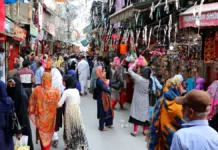
Viji Prakash’s mesmerizing story of Devadasis
Inspired by a photograph in Los Angeles County Museum Arts current exhibition Unveiling Femininity in Indian Painting and Photography (Two Nautch Girls on a Bed by William Hooper 1870), famed dancer, choreographer, Viji Prakash paid a magnificent tribute to the Devadasi heritage – Indian women dancers of the temple. Their art form is the basis for today’s BharataNatyam – the classical dance of Southern India. The Los Angeles County Museum of Arts’ Southern Asian Art Council, sponsored the production by Prakash’s ensemble – the Shakti Dance Company.
The 1,500 year old narrative of the Devadasi (female servant of the Gods) is a riveting one, spanning centuries of misrepresentation, complex interpretations and a history of veiled secrecy. Viji Prakash in her daring, unconventional, engrossing interpretation of the lives of Devadasis says,” though the story of the Devadasis in this production is fictional, I feel I have not strayed away from representing who they really were: master artists, true devotees of dance and repositories of our Indian Culture.”
The compelling, deeply humane and intriguing history of South Indian classical dance and the Devadasi, consort of the Immortal, puts Viji Prakash’s full range of craftsmanship on display. It compels us to a new understanding of our divided minds about Devadasis.
Viji Prakash hones her art to perfection with her distinctive style of technique, emotion and storytelling – as she delineates the stunning role of the temple dancers in the history of the art. She meticulously researched the collective memory of the Devadasis and presented a startling commentary on a woman’s status in the temple and beyond framed by colonialism and the changing times. She uses every tool, chanting, movement, dialogue, drama, and music, the visceral spectacle of dazzling costumes and jewelry, and brilliantly trained dancers.
Viji Prakash and her daughter, the acclaimed dancer, choreographer Mythili Prakash – have a unique gift of creativity and imagination. They collaborated through an inspiring dance form to reveal the lives of the Devadasis. Skilled dancers from the Shakti School of Dance depicted the joy and exhilaration of the lives of Devadasis in a suite of dances from the BharataNatyam repertoire which included the Alarippu, Varnam, Padams and more. They reconstructed the legacy of the Devadasis through scenes expressing the passion, love, honor and responsibility of these temple dancers in touching portraits.
The suite of BharataNatyam dance pieces were held together with rich pauses of drama, bhava (emotion), and clever dialogue for the elaboration of the Devadasi story. Viji Prakash re-interprets and conjures the life and times of the Devadasis with psychological detail, weaving the memories of two older Devadasis – Amma and Akka (Kay Talwar and Ambujam Panchanathan). These two Devadasis infused a deep sense of nostalgia and remembrance in the quiet dignity of their roles.
The younger Devadasis – Anuradha Kishore Ganpati and Kiran Bhalla – were sparkling, and saucy with a winsome freshness in their interactions and responses to each other and to Amma and Akka who became one of the most famous and respected Devadasis.
The two- hour dance drama unfolds in three parts; the initiation into temple dancing; the dances performed in the temple as an offering to the divine; the removal of the dance and dancer from the temple by the British and reformists; and Shiva as the “formless divine potential” who makes possible the heroic continuation of the dance and dancer.
The scenes are emotionally real and powerful as we see through their eyes the young dancers – the first day when they were initiated and stepped on rice paddy being blessed by their gurus. Choreographers Viji Prakash and Mythili Prakash opened our eyes to see the profound connection that dance had with Devadasis. They traced through movement and music, the wisdom, brightly faceted lives of the temple dancers. We see young children dedicated to the dance tradition, trained in the Scriptures and being inspired by the Devadasis yearning for the Divine.
Their mentors joyously shared their gifts of music, dance and yoga, chanting prayers, initiating young dancers in diverse arts using their privileges of patronage and wealth for nurturing beauty, spreading education and gifting their followers with blessings. Always with hearts full of love and devotion to the Divine.
The scenes depicting the British colonialists and reformers as well as Christian missionaries who arrived in the nineteenth century and dismissed the Devadasis as ill reputed women with a murky past was an anguished portrayal of the conflict, cruelty and dishonor brought on the Devadasis.
Dance in a sacred space was considered profane, and the children of the Devadasis illegitimate. Kay Talwar writes “As long as dance was a hereditary profession the Devadasi had a well-defined and important role in society. For 65 years the argument was fought in official circles until the death knell was struck with the passage of the 1947 Madras Devadasi Prevention of Dedication Act. The Devadasi era in the temples was drawing to a close.”
The story of the Devadasi ends triumphantly with revivalists ensuring that the ancient tradition would not be obliterated and today the dance – BharataNatyam a vibrant art form is alive and resonates around the globe.
The closeness of the music and the dance was a tremendous success. Vocals, flute, saxaphone, tabla, harmonium and even a drumset offered a wide range of rhythms and melodies that swept the audience into a glorious realm of classical music.
All praise to the artists. Arjun Narayanan (mridangam) and the four singers Bhairavi Dhandapani, Davita Dutta, Siri Sruthi Sarva, Anupama Tadanki and Pallavi Mynampati (flute).
Two brilliant members of the Aditya Prakash Ensemble Jake Jamieson (drums, Cajon, Doumbek) Neelamjit Dhillon (tabla, saxophone) astonished us by incorporating dazzling musical imagery and an underlying intense jazz harmonic structure into the program.
Prem Kishore






